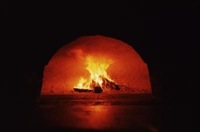Difference between revisions of "Refractory"
From Nordan Symposia
Jump to navigationJump to search (Created page with 'File:lighterstill.jpgright|frame ==Origin== alteration of ''refractary'', from Latin ''refractarius'', irregular from ''refragari''...') |
m (Text replacement - "http://" to "https://") |
||
| Line 3: | Line 3: | ||
==Origin== | ==Origin== | ||
alteration of ''refractary'', from [[Latin]] ''refractarius'', irregular from ''refragari'' to oppose, from ''re''- + -''fragari'' (as in ''suffragari'' to [[support]] with one's [[vote]]) | alteration of ''refractary'', from [[Latin]] ''refractarius'', irregular from ''refragari'' to oppose, from ''re''- + -''fragari'' (as in ''suffragari'' to [[support]] with one's [[vote]]) | ||
| − | *[ | + | *[https://en.wikipedia.org/wiki/17th_century 1606] |
==Definitions== | ==Definitions== | ||
*1: resisting [[control]] or [[authority]] : stubborn, unmanageable | *1: resisting [[control]] or [[authority]] : stubborn, unmanageable | ||
| Line 11: | Line 11: | ||
*3: [[difficult]] to [[fuse]], corrode, or draw out; especially : capable of enduring high [[temperature]] | *3: [[difficult]] to [[fuse]], corrode, or draw out; especially : capable of enduring high [[temperature]] | ||
==Description== | ==Description== | ||
| − | A '''refractory''' [[material]] is one that retains its [[strength]] at high [[temperatures]]. [ | + | A '''refractory''' [[material]] is one that retains its [[strength]] at high [[temperatures]]. [https://en.wikipedia.org/wiki/ASTM_International ASTM] C71 defines refractories as "non-metallic [[materials]] having those [[chemical]] and [[physical]] properties that make them applicable for [[structures]], or as components of systems, that are [[exposed]] to environments above 1,000 °F (811 K; 538 °C)". |
| − | Refractory materials are used in linings for furnaces, [ | + | Refractory materials are used in linings for furnaces, [https://en.wikipedia.org/wiki/Kiln kilns], incinerators and [https://en.wikipedia.org/wiki/Nuclear_reactor_technology reactors]. They are also used to make [https://en.wikipedia.org/wiki/Crucible crucibles].[https://en.wikipedia.org/wiki/Refractory] |
[[Category: General Reference]] | [[Category: General Reference]] | ||
Latest revision as of 02:32, 13 December 2020
Origin
alteration of refractary, from Latin refractarius, irregular from refragari to oppose, from re- + -fragari (as in suffragari to support with one's vote)
Definitions
- 1: resisting control or authority : stubborn, unmanageable
- 2a : resistant to treatment or cure <a refractory lesion>
- b : unresponsive to stimulus
- c : immune, insusceptible <after recovery they were refractory to infection>
- 3: difficult to fuse, corrode, or draw out; especially : capable of enduring high temperature
Description
A refractory material is one that retains its strength at high temperatures. ASTM C71 defines refractories as "non-metallic materials having those chemical and physical properties that make them applicable for structures, or as components of systems, that are exposed to environments above 1,000 °F (811 K; 538 °C)".
Refractory materials are used in linings for furnaces, kilns, incinerators and reactors. They are also used to make crucibles.[1]
